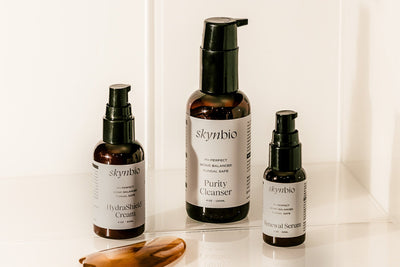If you struggle with fungal acne, seborrheic dermatitis, or other skin overgrowths, you know how frustrating it is to find skincare products that don’t make things worse. Unlike traditional acne, fungal acne (Malassezia folliculitis) and other yeast-related conditions aren't caused by bacteria or clogged pores—they’re fueled by an overgrowth of yeast (Malassezia) that thrives on certain skincare ingredients.
Many common ingredients—especially those found in moisturizers, oils, and emulsifiers—feed this yeast, leading to flare-ups, breakouts, and persistent irritation. To keep your skin clear and balanced, avoid these top offenders and choose fungal-safe alternatives instead.
1. Fatty Acids & Heavy Oils
Many skincare products are packed with fatty acids and rich oils to hydrate the skin. However, Malassezia feeds on certain fatty acids, making them a major trigger for fungal acne.
🚫 Avoid:
- Fatty acids with carbon chain lengths between C11 and C24, such as lauric acid, myristic acid, palmitic acid, and stearic acid.
- Oils high in oleic acid, such as coconut oil, olive oil, avocado oil, and argan oil.
✅ Use Instead:
- Squalane oil (a non-comedogenic oil that won’t feed yeast).
- Caprylic/Capric Triglycerides (MCT oil) (derived from coconut, but safe for fungal acne).
2. Esters & Emulsifiers
Esters and emulsifiers are often added to skincare to improve texture, but they combine fatty acids with alcohols, making them highly problematic for fungal-prone skin.
🚫 Avoid:
- Glyceryl Stearate
- Isopropyl Myristate
- Cetearyl Alcohol + Cetearyl Glucoside
✅ Use Instead:
- Lightweight, oil-free formulations with simple, microbiome-friendly ingredients.
3. Polysorbates
Polysorbates are common emulsifiers used to mix oil and water in skincare, but they can trap moisture and create a breeding ground for yeast overgrowth.
🚫 Avoid:
- Polysorbate 20, 60, 80 (commonly found in serums, cleansers, and lotions).
✅ Use Instead:
- Natural emulsifiers like lecithin or xanthan gum.
4. Shea Butter & Rich Butters
Shea butter is a go-to hydrating ingredient, but its heavy, occlusive nature can trap moisture and exacerbate fungal overgrowths.
🚫 Avoid:
- Shea butter, cocoa butter, and mango butter in moisturizers.
✅ Use Instead:
- Lightweight humectants like glycerin, sodium PCA, or urea for hydration.
5. Sodium Chloride (Table Salt)
Sodium chloride is often used as a thickening agent in creams and cleansers, but it can cause irritation and dryness, weakening the skin barrier and allowing yeast to thrive.
🚫 Avoid:
- Skincare products with sodium chloride high on the ingredient list.
✅ Use Instead:
- Gentle thickening agents like xanthan gum or cellulose.
6. Silicones & Occlusive Ingredients
Silicones help create a smooth texture in skincare and makeup, but some can trap oil, sweat, and bacteria, creating the perfect environment for fungal overgrowth.
🚫 Avoid:
- Dimethicone, Cyclopentasiloxane, and Trimethicone (if you notice flare-ups).
✅ Use Instead:
- Silicone-free formulations with breathable textures.
7. Fermented Ingredients & Probiotics
Fermented skincare ingredients can contain sugars and prebiotics that feed Malassezia, worsening fungal overgrowth.
🚫 Avoid:
- Fermented rice water, fermented yeast extract, kombucha extract, and probiotic skincare.
✅ Use Instead:
- Niacinamide & azelaic acid (to calm inflammation and regulate oil production).
8. High-Concentration Alcohols
While not all alcohols are bad, high concentrations of drying alcohols strip the skin’s protective barrier, making it more prone to fungal flare-ups.
🚫 Avoid:
- Ethanol, denatured alcohol, isopropyl alcohol in toners & serums.
✅ Use Instead:
- Hydrating toners with chamomile, green tea, or cucumber extract.
What Ingredients Are Fungal-Safe?
If you have fungal acne or microbiome-related skin conditions, stick to gentle, antifungal, and microbiome-friendly ingredients that balance, hydrate, and protect your skin without triggering breakouts.
✔ Niacinamide – Regulates oil production and reduces inflammation.
✔ Squalane Oil – A lightweight, non-comedogenic oil that won’t feed yeast.
✔ Azelaic Acid – A gentle exfoliant with antifungal and anti-inflammatory properties.
✔ Sulfur & Zinc PCA – Naturally antifungal, helping to control Malassezia overgrowth.
✔ Tea Tree Oil – A natural antifungal (must be properly diluted).
✔ Hyaluronic Acid & Glycerin – Lightweight hydrators that won’t clog pores.
Fungal-Safe Skincare Made Simple
Understanding which ingredients to avoid is key to managing fungal acne and other skin overgrowths effectively. Many common skincare products feed yeast and disrupt the microbiome, making it difficult to heal.
At Skynbio, we’ve done the hard work for you—our Clear Balance Trio is a 3-step fungal-safe solution designed to keep your routine simple without the risk of hidden triggers.
✨ Ditch the guesswork and upgrade to Skynbio’s science-backed, fungal-safe skincare. ✨
🛍️ Try the Clear Balance Trio risk-free with our 30-day satisfaction guarantee!




